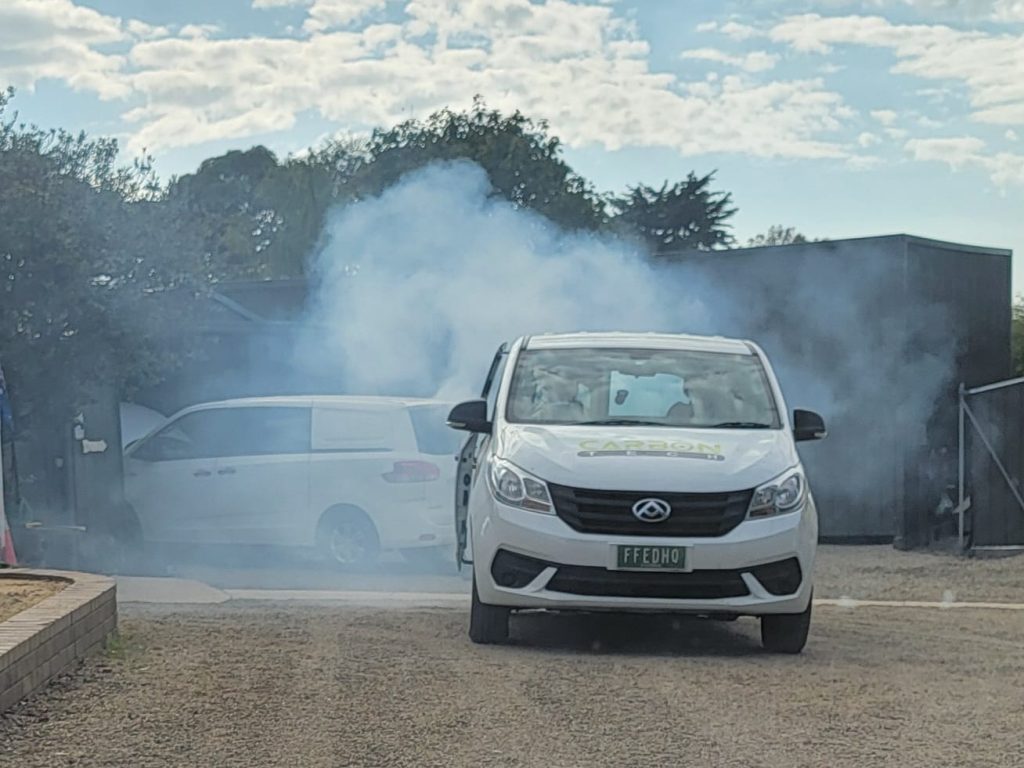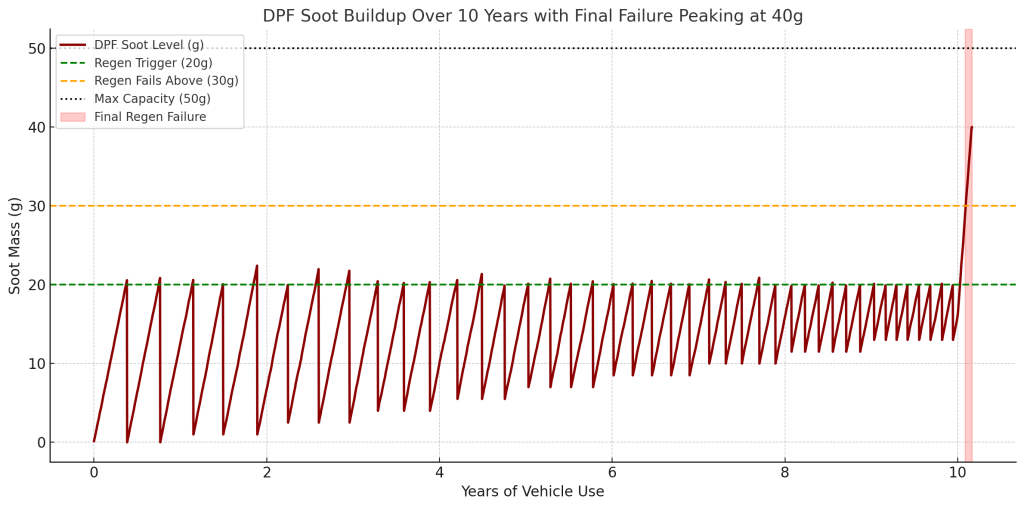Why Did My DPF Suddenly Clog Up When It Was Fine Before?

Why Did My DPF Suddenly Clog Up When It Was Fine Before?
You’ve been driving your diesel vehicle for years with no issues, then out of nowhere — the dreaded DPF warning light comes on. You’re asking yourself: “Why now? It’s never been a problem before!”
At Carbon Tech, we’ve seen it all.
Some diesel vehicles have their DPF warning light come on at just 40,000km, while others clock over 300,000km without a single DPF problem.
But why is there such a big difference?
The answer is simple: how you drive your diesel car.
Modern Euro 5 standard diesel vehicles are designed to trap and contain emissions inside the car’s systems — making everything work harder and linking components more closely together. However, the biggest factor that affects your DPF’s health is still your driving style.
Unlike petrol engines, diesel engines warm up very slowly. All the parts inside a diesel engine — including the turbo, EGR valve, and DPF system — are designed to operate efficiently only at full operating temperature.
On cold days, especially in city driving, a diesel engine may need up to 15 minutes just to reach the correct operating temperature.
By the time the engine warms up, you may have already finished your trip — meaning the engine never properly reaches its efficient running conditions.
Without reaching operating temperature, the engine produces excess soot, and the DPF can’t regenerate properly. Over time, this leads to clogging.
Many people ask — if my DPF has been working fine for years, why does it suddenly clog up now?
The truth is, a DPF is a filter that constantly traps soot from your engine.
Every time you start your diesel engine, your intake system and fuel injectors slowly get dirtier over time. As these areas get contaminated, the engine produces more soot than it did when the car was new.
This is especially true if your driving style involves a lot of:
Start-stop traffic
Short trips
City driving conditions
Over time, the DPF regeneration cycle struggles to keep up with the extra soot production. Eventually, soot loading rises faster than the system can burn off — and that’s when the DPF warning light comes on.
The Three Main Reasons DPFs Clog Up
There are three key reasons why DPF clogging happens, sometimes much earlier than expected:
🚗 1. Driving Style
Your driving habits have a major impact on your DPF health.
Frequent short trips, stop-start traffic, and prolonged idling prevent the DPF from reaching the temperature needed to regenerate and burn off soot.
As a result, soot keeps building up inside the filter.
Common driving style issues:
Short trips: Engine and exhaust never fully heat up.
Heavy city driving: Too much stopping and starting, keeping exhaust temps too low.
Extended idling: Engine runs cold and produces more soot.
Tip:
Include regular highway drives at speeds over 60km/h to allow the DPF to complete passive regeneration properly.
🔧 2. Soot Loading from Dirty Intake and Fuel Injectors
If the intake system or fuel injectors become dirty, your engine’s combustion becomes less efficient.
This leads to more soot production, which loads up the DPF faster than it can burn off.
Key causes of extra soot:
Clogged injectors: Poor fuel spray patterns cause incomplete combustion.
Restricted intake: Poor airflow makes the engine run rich, producing more soot.
Tip:
Clean your intake and fuel system regularly to maintain optimal combustion and reduce soot build-up.
⚙️ 3. Engine Component Failures
Mechanical problems can also prevent your DPF from working properly, even if you drive carefully.
Common mechanical causes:
Faulty sensors: Incorrect readings disrupt regeneration timing.
Broken hoses: Boost leaks and vacuum leaks can cause poor combustion.
Oil leaks: Oil entering the DPF turns to ash and clogs the filter.
Turbocharger failures: Oil leaking into the exhaust from the turbo quickly blocks the DPF.
EGR valve problems: A stuck EGR valve increases soot output dramatically.
Tip:
Catch mechanical issues early through regular inspections to avoid unnecessary DPF problems.
⚠️ How These Problems Lead to Out-of-Control Soot Loading
All three of the main causes — bad driving habits, dirty intake and injectors, and mechanical failures — can cause soot loading to skyrocket.
When soot mass rises too high, the DPF can no longer safely perform an active regeneration.
Attempting to burn off an excessive amount of soot can overheat and permanently damage the DPF.
When this happens, the vehicle will trigger the DPF warning light, warning you that the system is overloaded and that professional cleaning or repairs are urgently required.
Once the DPF light comes on, normal driving won’t fix it — you’ll need a proper DPF clean to restore performance.

📊 What This Graph Tells You About DPF Soot Build-Up
[DPF Soot Graph Over 10 Years – Simulated Example]
The graph above illustrates how DPF soot levels can build up gradually over time, even when a vehicle is actively regenerating.
Here’s what it shows:
✅ Year 1: Regens Are Fully Effective
In the first year, regeneration works perfectly. It’s triggered at 20g and brings soot levels all the way back down to 0g, keeping the DPF clean and functioning well.
🔁 Year 2 Onward: More Frequent Regens, But Less Effective
As the DPF system ages, residual soot begins to accumulate. Regens are triggered more frequently (every ~6.5 days, then daily by Year 10), but each cycle leaves behind a little more soot — 1g, then 2g, then 5g, etc. This is often caused by ash build-up, which regens can’t remove.
🟧 Regen Failure Begins to Show
As soot loading increases, some regens begin to fail, especially as levels approach or exceed 30g. This failure might be due to:
Interrupted regen cycles
Driving conditions (short trips, low load)
Faulty sensors or EGR issues
Eventually, even frequent regeneration can’t keep up.
🔴 Final Phase: Total Regen Failure
In the final 30 days, regeneration no longer works at all. Soot rapidly increases and peaks at 40g, leading to poor engine performance and high risk of limp mode or permanent DPF damage.
⚠️ Every Vehicle Is Different
This graph represents a general example of how DPF regeneration can behave over time.
Trigger points, regen intervals, and failure thresholds will vary depending on the vehicle make, model, engine, and driving conditions.
Some vehicles may:
Trigger regen earlier (e.g., at 15g)
Tolerate higher soot loads before failing
Regenerate faster or slower
That’s why at CarbonTech, we always start with a full diagnostic check to see exactly where your system stands.
This full approach reduces soot loading from the source, so your DPF doesn’t have to regen as often — or at all.
👉 Read more about why DPF, fuel system, and intake cleaning go hand-in-hand
What Should You Ask Yourself When the DPF Light Comes On?
If your DPF warning light turns on, the first thing you should ask yourself is:
Am I mostly driving in start-stop conditions?
If yes, your DPF is most likely clogged up because of gradual soot buildup due to a dirty intake system and fuel injectors.
Over time, soot loading increases to a level where the DPF’s regeneration system simply can’t keep up anymore.
However, if you normally drive long distances and the DPF light suddenly comes on, it could indicate a different problem — engine component failure.
Ask yourself:
Has the car recently been serviced?
Incorrect servicing (such as wrong oil type or missed checks) can cause DPF issues.
Is the intake system leaking?
Intake air leaks can throw off combustion, increasing soot production.
Has the engine oil level risen above the maximum mark?
If yes, this could mean diesel contamination from failed regenerations, pointing to serious engine-related DPF problems.
In these cases, the DPF is not the root problem — it is a symptom of something else wrong with the engine that must be fixed first.
Final Words
DPF clogging is not just bad luck — it’s mostly the result of how the car is driven, maintained, and whether mechanical problems are addressed early.
By understanding these three main causes and making a few changes to how you drive and maintain your diesel, you can easily avoid sudden DPF blockages and expensive repairs.
Need professional help with a blocked DPF?
[Contact us here] and let Carbon Tech bring your diesel car back to life!